Machine Learning for Wind Speed Estimation
Abstract
1. Introduction
2. Analysis of Wind Research Utilizing Machine Learning in Built Environment
3. Materials and Methods
3.1. Material
3.2. Method
3.2.1. Method for In Situ Measurements
3.2.2. Computational Fluid Dynamics Analysis Method
3.2.3. Machine Learning-Based Analysis Method
- ▪
- Autodesk Forma is accessible via an educational account, which is freely available to researchers. This accessibility makes it an excellent tool for educational and research institutions worldwide, ensuring that advanced ML capabilities are not restricted to those with funding. Additionally, the platform is particularly beneficial for researchers and practitioners lacking extensive coding skills, enabling them to leverage advanced ML tools effectively.
- ▪
- Unlike static ML models, Autodesk Forma learns and improves continuously. It adapts based on new data and user interactions, which means that with each simulation, it refines its algorithms and enhances its predictive accuracy.
- ▪
- For ongoing validation, Autodesk employs a real-time strategy: the surrogate model is triggered during wind analyses and its output is compared with the expected results. This ensures that the model stays aligned with how users currently model buildings and their surroundings. Consequently, the surrogate models offer timely, context-aware approximations, making them effective within the Autodesk Forma environment but less so outside of it. Still, the model maintains diversity and relevance by incorporating a wide range of urban and climatic inputs from users.
- ▪
- The use of a dynamic, widely accessible ML tool is significant not only for its immediate analytical capabilities but also for its implications in democratizing advanced computational tools in architecture. This aligns with our research goal of exploring practical, accessible solutions for enhancing urban wind comfort.
3.2.4. Comparison of CFD and ML to In Situ Measurements
4. Analysis and Results
4.1. Results of the In Situ Measurements
4.2. Results of the CFD Analysis
4.3. Results of the ML-Based Analysis
4.4. Comparison of the CFD and ML-Based Analysis with In Situ Measurements
5. Discussion and Limitations
6. Conclusions
Author Contributions
Funding
Data Availability Statement
Conflicts of Interest
Abbreviations
| AIJ | Architectural Institute of Japan |
| ANNs | Artificial Neural Networks |
| CFD | Computational fluid dynamics |
| CoL | City of London |
| COST | European Cooperation in Science and Technology |
| DL | Deep learning |
| FNN | Feedforward Neural Network |
| GANs | Generative Adversarial Networks |
| GIS | Geographic Information System |
| KNNs | k-Nearest Neighbors |
| ML | Machine learning |
| NAR | Non-Autoregressive |
| NARX | Nonlinear Autoregressive with eXogenous Inputs |
| NNN | Nearest Neighbor Network |
| RBFNN | Radial Basis Function Neural Network |
| SFGAN | Spatial-Frequency Generative Adversarial Network |
| U-Net | U-shaped Convolutional Neural Network |
References
- Chen, Q. Using Computational Tools to Factor Wind into Architectural Environment Design. Energy Build. 2004, 36, 1197–1209. [Google Scholar] [CrossRef]
- Carrilho da Graça, G.; Linden, P. Ten Questions About Natural Ventilation of Non-Domestic Buildings. Build. Environ. 2016, 107, 263–273. [Google Scholar] [CrossRef]
- Zhang, R.; Liu, D.; Shi, L. Thermal-Comfort Optimization Design Method for Semi-Outdoor Stadium Using Machine Learning. Build. Environ. 2022, 215, 108890. [Google Scholar] [CrossRef]
- Tablada, A.; Blocken, B.; Carmeliet, J.; Zurich, E.; Troyer, F.; Verschure, H. The Influence of Courtyard Geometry on Air Flow and Thermal Comfort: CFD and Thermal Comfort Simulations. In Proceedings of the 22nd Conference on Passive and Low Energy Architecture, Beirut, Lebanon, 13–16 November 2005. [Google Scholar]
- Ngarambe, J.; Yun, G.Y.; Santamouris, M. The Use of Artificial Intelligence (AI) Methods in the Prediction of Thermal Comfort in Buildings: Energy Implications of AI-Based Thermal Comfort Controls. Energy Build. 2020, 211, 109807. [Google Scholar] [CrossRef]
- Gençer, F.; Karadağ, İ. Numerical Evaluation of Pedestrian-Level Wind and Indoor Thermal Comfort of a Historical Monument, Muğla, Türkiye; Open House International: Fairfiled, CA, USA, 2022; Volume 47. [Google Scholar]
- Eslamirad, N.; Luca, F.; Sakari Lylykangas, K.; Ben Yahia, S. Data Generative Machine Learning Model for the Assessment of Outdoor Thermal and Wind Comfort in a Northern Urban Environment. Front. Archit. Res. 2023, 12, 541–555. [Google Scholar] [CrossRef]
- Kastner, P.; Dogan, T. Eddy3D: A Toolkit for Decoupled Outdoor Thermal Comfort Simulations in Urban Areas. Build. Environ. 2022, 212, 108639. [Google Scholar] [CrossRef]
- Gülmüş, S.; Alaçam, S.; Güzelci, O.Z. Harran Earthen Houses as a Precedent for Environmental Comfort. J. Cult. Herit. Manag. Sustain. Dev. 2024. ahead-of-print. [Google Scholar] [CrossRef]
- Young, E.; Kastner, P.; Dogan, T.; Chokhachian, A.; Mokhtar, S.; Reinhart, C. Modeling Outdoor Thermal Comfort along Cycling Routes at Varying Levels of Physical Accuracy to Predict Bike Ridership in Cambridge, MA. Build. Environ. 2022, 208, 108577. [Google Scholar] [CrossRef]
- Willemsen, E.; Wisse, J.A. Design for Wind Comfort in The Netherlands: Procedures, Criteria and Open Research Issues. J. Wind Eng. Ind. Aerodyn. 2007, 95, 1541–1550. [Google Scholar] [CrossRef]
- Urban Design and Landscape Architecture Planning and Development Services; RWDI. UDLAPDS Pedestrian Level Wind Study Terms of Reference Guide; Urban Design and Landscape Architecture Planning and Development Services: Niagara Falls, ON, Canada, 2023. [Google Scholar]
- Zhang, X.; Tse, K.T.; Weerasuriya, A.U.; Li, S.W.; Kwok, K.C.S.; Mak, C.M.; Niu, J.; Lin, Z. Evaluation of Pedestrian Wind Comfort near ‘Lift-up’ Buildings with Different Aspect Ratios and Central Core Modifications. Build. Environ. 2017, 124, 245–257. [Google Scholar] [CrossRef]
- Mittal, H.; Sharma, A.; Gairola, A. A Review on the Study of Urban Wind at the Pedestrian Level around Buildings. J. Build. Eng. 2018, 18, 154–163. [Google Scholar] [CrossRef]
- Mazauric, L.; Demers, C.M.; Potvin, A. Climate Form Finding for Architectural Inhabitability. Ambiances 2018, 4, 1–29. [Google Scholar] [CrossRef]
- Gao, H.; Hu, G.; Zhang, D.; Jiang, W.; Tse, K.T.; Kwok, K.C.S.; Kareem, A. Urban Wind Field Prediction Based on Sparse Sensors and Physics-Informed Graph-Assisted Auto-Encoder. Comput.-Aided Civ. Infrastruct. Eng. 2024, 39, 1409–1430. [Google Scholar] [CrossRef]
- He, Y.; Liu, Z.; Ng, E. Parametrization of Irregularity of Urban Morphologies for Designing Better Pedestrian Wind Environment in High-Density Cities—A Wind Tunnel Study. Build. Environ. 2022, 226, 109692. [Google Scholar] [CrossRef]
- Zaki, S.A.; Azid, N.S.; Shahidan, M.F.; Hassan, M.Z.; Md Daud, M.Y.; Abu Bakar, N.A.; Ali, M.S.M.; Yakub, F. Analysis of Urban Morphological Effect on the Microclimate of the Urban Residential Area of Kampung Baru in Kuala Lumpur Using a Geospatial Approach. Sustainability 2020, 12, 7301. [Google Scholar] [CrossRef]
- Gao, Y.; Yao, R.; Li, B.; Turkbeyler, E.; Luo, Q.; Short, A. Field Studies on the Effect of Built Forms on Urban Wind Environments. Renew Energy 2012, 46, 148–154. [Google Scholar] [CrossRef]
- Murakami, S.; Zeng, J.; Hayashi, T. CFD Analysis of Wind Environment around a Human Body. J. Wind Eng. Ind. Aerodyn. 1999, 83, 393–408. [Google Scholar] [CrossRef]
- Kabošová, L.; Chronis, A.; Galanos, T. Fast Wind Prediction Incorporated in Urban City Planning. Int. J. Archit. Comput. 2022, 20, 511–527. [Google Scholar] [CrossRef]
- Knipe, W.; Petersen, N. Pedestrian Level Wind Study; Gradient Wind Engineering Inc.: Toronto, ON, Canada, 2023. [Google Scholar]
- Terry, E.Q.X. Wind Design in Smart Cities. Landsc. Archit. 2020, 27, 64–70. [Google Scholar]
- Zhang, A.; Gao, C.; Zhang, L. Numerical Simulation of the Wind Field around Different Building Arrangements. J. Wind Eng. Ind. Aerodyn. 2005, 93, 891–904. [Google Scholar] [CrossRef]
- Blocken, B.; Persoon, J. Pedestrian Wind Comfort around a Large Football Stadium in an Urban Environment: CFD Simulation, Validation and Application of the New Dutch Wind Nuisance Standard. J. Wind Eng. Ind. Aerodyn. 2009, 97, 255–270. [Google Scholar] [CrossRef]
- Blocken, B.; Janssen, W.D.; van Hooff, T. CFD Simulation for Pedestrian Wind Comfort and Wind Safety in Urban Areas: General Decision Framework and Case Study for the Eindhoven University Campus. Environ. Model. Softw. 2012, 30, 15–34. [Google Scholar] [CrossRef]
- Montazeri, H.; Blocken, B.; Janssen, W.D.; van Hooff, T. CFD Evaluation of New Second-Skin Facade Concept for Wind Comfort on Building Balconies: Case Study for the Park Tower in Antwerp. Build. Environ. 2013, 68, 179–192. [Google Scholar] [CrossRef]
- Tang, X.; Stoevesandt, B.; Fan, B.; Li, S.; Yang, Q.; Tayjasanant, T.; Sun, Y. An On-Site Measurement Coupled CFD Based Approach for Wind Resource Assessment over Complex Terrains. In Proceedings of the IEEE Instrumentation and Measurement Society Technology Conference, Houston, TX, USA, 14–17 May 2018; pp. 1–6. [Google Scholar]
- Tominaga, Y.; Mochida, A.; Yoshie, R.; Kataoka, H.; Nozu, T.; Yoshikawa, M.; Shirasawa, T. AIJ Guidelines for Practical Applications of CFD to Pedestrian Wind Environment around Buildings. J. Wind Eng. Ind. Aerodyn. 2008, 96, 1749–1761. [Google Scholar] [CrossRef]
- Bottema, M.; Leene, J.A.; Wisse, J.A. Towards Forecasting of Wind Comfort. J. Wind Eng. Ind. Aerodyn. 1992, 44, 2365–2376. [Google Scholar] [CrossRef]
- Wu, H.; Kriksic, F. Designing for Pedestrian Comfort in Response to Local Climate. J. Wind Eng. Ind. Aerodyn. 2012, 104–106, 397–407. [Google Scholar] [CrossRef]
- Stathopoulos, T. Computational Wind Engineering: Past Achievements and Future Challenges. J. Wind Eng. Ind. Aerodyn. 1997, 67–68, 509–532. [Google Scholar] [CrossRef]
- Janssen, W.D.; Blocken, B.; Hooff, T. Pedestrian Wind Comfort around Buildings: Comparison of Wind Comfort Criteria Based on Whole-Flow Field Data for a Complex Case Study. Build. Environ. 2013, 59, 547–562. [Google Scholar] [CrossRef]
- Juan, Y.H.; Wen, C.Y.; Li, Z.; Yang, A.S. A Combined Framework of Integrating Optimized Half-Open Spaces into Buildings and an Application to a Realistic Case Study on Urban Ventilation and Air Pollutant Dispersion. J. Build. Eng. 2021, 44, 102975. [Google Scholar] [CrossRef]
- Murakami, S.; Ooka, R.; Mochida, A.; Yoshida, S.; Kim, S. CFD Analysis of Wind Climate from Human Scale to Urban Scale. J. Wind Eng. Ind. Aerodyn. 1999, 81, 57–81. [Google Scholar] [CrossRef]
- Yoshie, R.; Mochida, A.; Tominaga, Y.; Kataoka, H.; Harimoto, K.; Nozu, T.; Shirasawa, T. Cooperative Project for CFD Prediction of Pedestrian Wind Environment in the Architectural Institute of Japan. J. Wind Eng. Ind. Aerodyn. 2007, 95, 1551–1578. [Google Scholar] [CrossRef]
- Blocken, B.; Roels, S.; Carmeliet, J. Modification of Pedestrian Wind Comfort in the Silvertop Tower Passages by an Automatic Control System. J. Wind Eng. Ind. Aerodyn. 2004, 92, 849–873. [Google Scholar] [CrossRef]
- Liu, J.; Niu, J. CFD Simulation of the Wind Environment around an Isolated High-Rise Building: An Evaluation of SRANS, LES and DES Models. Build Environ. 2016, 96, 91–106. [Google Scholar] [CrossRef]
- Karadağ, İ.; Serteser, N. An Algorithm for Estimation of Wind-Building Interaction in the Early Design Stage; Faculty of Architecture, MEGARON/Yıldız Technical University: Istanbul, Türkiye, 2019. [Google Scholar]
- City of London Corporation. Wind Microclimate Guidelines; City of London Corporation: London, UK, 2019. [Google Scholar]
- Franke, J.; Hellsten, A.; Sclünzen, H.; Carissimo, B. Cost Action 732 in Combination with the European Science Foundation at Hamburg, Germany, 2005; European Science Foundation: Hamburg, Germany, 2007. [Google Scholar]
- Yan, B.W.; Li, Q.S. Coupled On-Site Measurement/CFD Based Approach for High-Resolution Wind Resource Assessment over Complex Terrains. Energy Convers. Manag. 2016, 117, 351–366. [Google Scholar] [CrossRef]
- Wang, Z.J.; Fidkowski, K.; Abgrall, R.; Bassi, F.; Caraeni, D.; Cary, A.; Deconinck, H.; Hartmann, R.; Hillewaert, K.; Huynh, H.T.; et al. High-Order CFD Methods: Current Status and Perspective. Int. J. Numer. Methods Fluids 2013, 72, 811–845. [Google Scholar] [CrossRef]
- Ding, C.; Lam, K.P. Data-Driven Model for Cross Ventilation Potential in High-Density Cities Based on Coupled CFD Simulation and Machine Learning. Build. Environ. 2019, 165, 106394. [Google Scholar] [CrossRef]
- Liu, Y.S.; Yigitcanlar, T.; Guaralda, M.; Degirmenci, K.; Liu, A.; Kane, M. Leveraging the Opportunities of Wind for Cities through Urban Planning and Design: A PRISMA Review. Sustainability 2022, 14, 11665. [Google Scholar] [CrossRef]
- Tamke, M.; Nicholas, P.; Zwierzycki, M. Machine Learning for Architectural Design: Practices and Infrastructure. Int. J. Archit. Comput. 2018, 16, 123–143. [Google Scholar] [CrossRef]
- Karadag, I.; Güzelci, O.Z.; Alaçam, S. EDU-AI: A Twofold Machine Learning Model to Support Classroom Layout Generation. Constr. Innov. 2023, 23, 898–914. [Google Scholar] [CrossRef]
- Khean, N.; Fabbri, A.; Haeusler, M.H. Learning Machine Learning as an Architect, How to? Presenting and Evaluating a Grasshopper Based Platform to Teach Architecture Students Machine Learning. In Proceedings of the 36th eCAADe Conference—Volume 1, Lodz University of Technology, Lodz, Poland, 19–21 September 2018. [Google Scholar]
- Alaçam, S.; Karadag, I.; Zeynel Güzelci, O. Reciprocal Style and Information Transfer between Historical Istanbul Pervititch Maps and Satellite Views Using Machine Learning. Estoa 2022, 11, 71–81. [Google Scholar] [CrossRef]
- Güzelci, O.Z.; Alaçam, S.; Bekiroğlu, B.; Karadag, I. A Machine Learning-Based Prediction Model for Architectural Heritage: The Case of Domed Sinan Mosques. Digit. Appl. Archaeol. Cult. Herit. 2024, 35, e00370. [Google Scholar] [CrossRef]
- KURUÇAY, E.; KARADAĞ, İ. Computational Approaches in 21st Century Architectural Design: Defining Digital Representation Methods. Düzce Üniv. Bilim Teknol. Derg. 2022, 10, 1201–1217. [Google Scholar] [CrossRef]
- Zheng, H.; Yuan, P.F. A Generative Architectural and Urban Design Method through Artificial Neural Networks. Build. Environ. 2021, 205, 108178. [Google Scholar] [CrossRef]
- Su, S.; Zang, Z.; Yuan, J.; Pan, X.; Shan, M. Considering Critical Building Materials for Embodied Carbon Emissions in Buildings: A Machine Learning-Based Prediction Model and Tool. Case Stud. Constr. Mater. 2024, 20, e02887. [Google Scholar] [CrossRef]
- Yan, B.; Ding, W.; Jin, Z.; Zhang, L.; Wang, L.; Du, M.; Yang, Q.; He, Y. Explainable Machine Learning-Based Prediction for Aerodynamic Interference of a Low-Rise Building on a High-Rise Building. J. Build. Eng. 2024, 82, 108285. [Google Scholar] [CrossRef]
- Kastner, P.; Dogan, T. A GAN-Based Surrogate Model for Instantaneous Urban Wind Flow Prediction. Build. Environ. 2023, 242, 110384. [Google Scholar] [CrossRef]
- Gür, M.; Karadag, I. Machine Learning for Pedestrian-Level Wind Comfort Analysis. Buildings 2024, 14, 1845. [Google Scholar] [CrossRef]
- Low, S.J.; Venugopalan; Raghavan, S.G.; Gopalan, H.; Wong, J.C.; Yeoh, J.; Ooi, C.C. FastFlow: AI for Fast Urban Wind Velocity Prediction. In Proceedings of the 2022 IEEE International Conference on Data Mining Workshops (ICDMW), Orlando, FL, USA, 8 February 2023. [Google Scholar]
- Blocken, B.; Stathopoulos, T.; van Beeck, J.P.A.J. Pedestrian-Level Wind Conditions around Buildings: Review of Wind-Tunnel and CFD Techniques and Their Accuracy for Wind Comfort Assessment. Build. Environ. 2016, 100, 50–81. [Google Scholar] [CrossRef]
- Wind Comfort Analysis. Available online: https://orbitalstack.com/ai-powered-wind-simulations/ (accessed on 15 March 2025).
- Chronis, A.; Aichinger, A.; Duering, S.; Galanos, T.; Fink, T.; Vesely, O. Infrared an Intelligent Framework for Resilient Design. In Proceedings of the International Conference of the Association for Computer-Aided Architectural Design Research in Asia (CAADRIA), Bangkok, Thailand, 5–6 August 2020. [Google Scholar]
- Khosravi, A.; Koury, R.N.N.; Machado, L.; Pabon, J.J.G. Prediction of Wind Speed and Wind Direction Using Artificial Neural Network, Support Vector Regression and Adaptive Neuro-Fuzzy Inference System. Sustain. Energy Technol. Assess. 2018, 25, 146–160. [Google Scholar] [CrossRef]
- Blanchard, T.; Samanta, B. Wind Speed Forecasting Using Neural Networks. Wind Eng. 2020, 44, 33–48. [Google Scholar] [CrossRef]
- Takhmasib, M.; Lee, H.J.; Yi, H. Machine-Learned Kinetic Façade: Construction and Artificial Intelligence Enabled Predictive Control for Visual Comfort. Autom. Constr. 2023, 156, 105093. [Google Scholar] [CrossRef]
- Zhang, A.; Zhang, L. RBF Neural Networks for the Prediction of Building Interference Effects. Comput. Struct. 2004, 82, 2333–2339. [Google Scholar] [CrossRef]
- Park, H.; Park, D.Y. Comparative Analysis on Predictability of Natural Ventilation Rate Based on Machine Learning Algorithms. Build. Environ. 2021, 195, 107744. [Google Scholar] [CrossRef]
- BenMoshe, N.; Fattal, E.; Leitl, B.; Arav, Y. Using Machine Learning to Predict Wind Flow in Urban Areas. Atmosphere 2023, 14, 990. [Google Scholar] [CrossRef]
- Dongmei, H.; Shiqing, H.; Xuhui, H.; Xue, Z. Prediction of Wind Loads on High-Rise Building Using a BP Neural Network Combined with POD. J. Wind Eng. Ind. Aerodyn. 2017, 170, 1–17. [Google Scholar] [CrossRef]
- Tian, J.; Gurley, K.R.; Diaz, M.T.; Fernández-Cabán, P.L.; Masters, F.J.; Fang, R. Low-Rise Gable Roof Buildings Pressure Prediction Using Deep Neural Networks. J. Wind Eng. Ind. Aerodyn. 2020, 196, 104026. [Google Scholar] [CrossRef]
- Fu, D.Q.; Zhu, B.Z.; Zhu, H.L.; Zhang, H.X.; Xie, Y.H.; Jiang, W.B.; Zhao, X.D.; Luo, Y.B. Prediction of Wind Loads on a Large Flat Roof Using Fuzzy Neural Networks. Eng. Struct. 2006, 28, 153–161. [Google Scholar] [CrossRef]
- Duering, S.; Chronis, A.; Koenig, R. Optimizing Urban Systems: Integrated Optimization of Spatial Configurations. In Proceedings of the SimAUD (Symposium on Simulation in Architecture Urban Design), Online, 25–27 May 2020; pp. 503–509. [Google Scholar]
- English, E.C.; Fricke, F.R. The Interference Index and Its Prediction Using a Neural Network Analysis of Wind-Tunnel Data. J. Wind Eng. Ind. Aerodyn. 1999, 83, 567–575. [Google Scholar] [CrossRef]
- Higgins, S.; Stathopoulos, T. Application of Artificial Intelligence to Urban Wind Energy. Build. Environ. 2021, 197, 107848. [Google Scholar] [CrossRef]
- Begam, K.M.; Deepa, S.N. Optimized Nonlinear Neural Network Architectural Models for Multistep Wind Speed Forecasting. Comput. Electr. Eng. 2019, 78, 32–49. [Google Scholar] [CrossRef]
- Wang, P.; Guo, M.; Cao, Y.; Hao, S.; Zhou, X.; Zhao, L. Pedestrian Wind Flow Prediction Using Spatial-Frequency Generative Adversarial Network. Build. Simul. 2023, 17, 319–334. [Google Scholar] [CrossRef]
- Kong, M.; Yu, M.; Liu, N.; Gao, P.; Wang, Y.; Zhang, J. Combined Gis, Cfd and Neural Network Multi-Zone Model for Urban Planning and Building Simulation. In Proceedings of the Building Simulation Conference Proceedings, San Francisco, CA, USA, 7–9 August 2017; International Building Performance Simulation Association: Britton, SD, USA, 2017; Volume 5, pp. 2392–2397. [Google Scholar]
- Khanduri, A.C.; Brdard, C.; Stathopoulos, T. Modelling Wind-Induced Interference Effects Using Backpropagation Neural Networks. J. Wind. Eng. Ind. Aerodyn. 1997, 72, 71–79. [Google Scholar] [CrossRef]
- Mortezazadeh, M.; Zou, J.; Hosseini, M.; Yang, S.; Wang, L. Estimating Urban Wind Speeds and Wind Power Potentials Based on Machine Learning with City Fast Fluid Dynamics Training Data. Atmosphere 2022, 13, 214. [Google Scholar] [CrossRef]
- Demolli, H.; Dokuz, A.S.; Ecemis, A.; Gokcek, M. Wind Power Forecasting Based on Daily Wind Speed Data Using Machine Learning Algorithms. Energy Convers. Manag. 2019, 198, 111823. [Google Scholar] [CrossRef]
- Werner, J.; Nowak, D.; Hunger, F.; Johnson, T.; Mark, A.; Gösta, A.; Edelvik, F. Predicting Wind Comfort in an Urban Area: A Comparison of a Regression- with a Classification-CNN for General Wind Rose Statistics. Mach. Learn. Knowl. Extr. 2024, 6, 98–125. [Google Scholar] [CrossRef]
- Kabošová, L.; Chronis, A.; Galanos, T.; Kmeť, S.; Katunský, D. Shape Optimization during Design for Improving Outdoor Wind Comfort and Solar Radiation in Cities. Build. Environ. 2022, 226, 109668. [Google Scholar] [CrossRef]

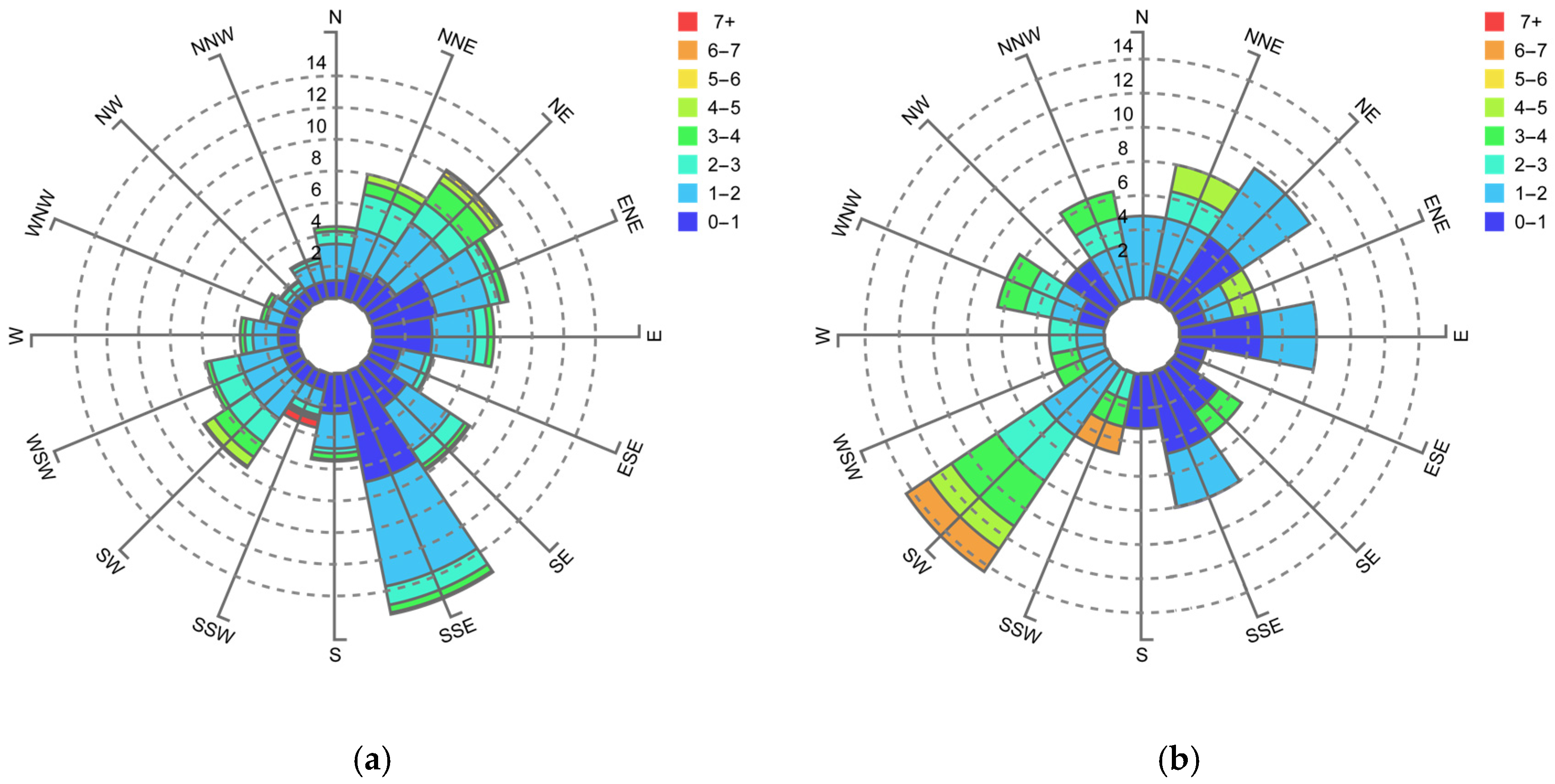
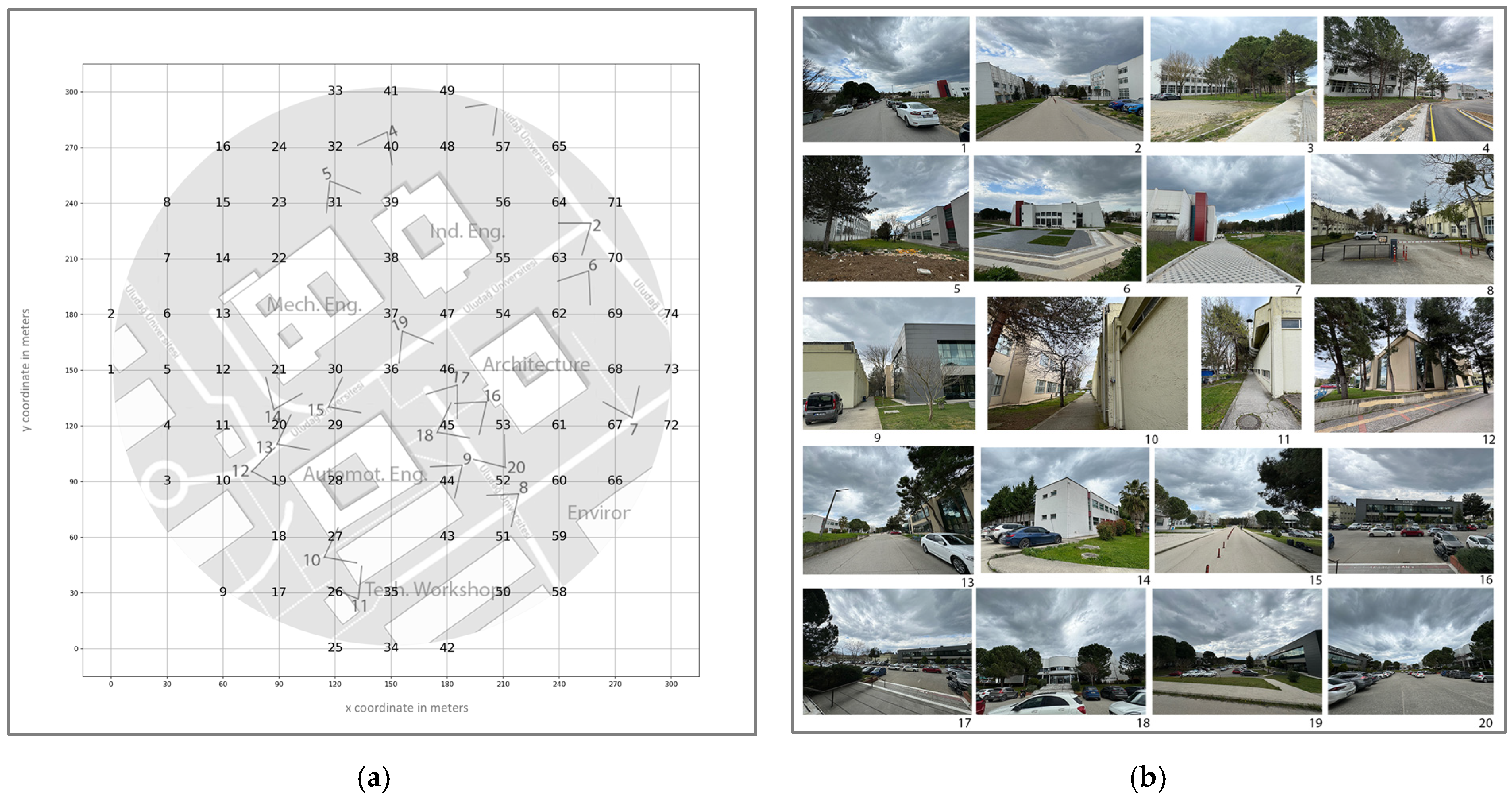
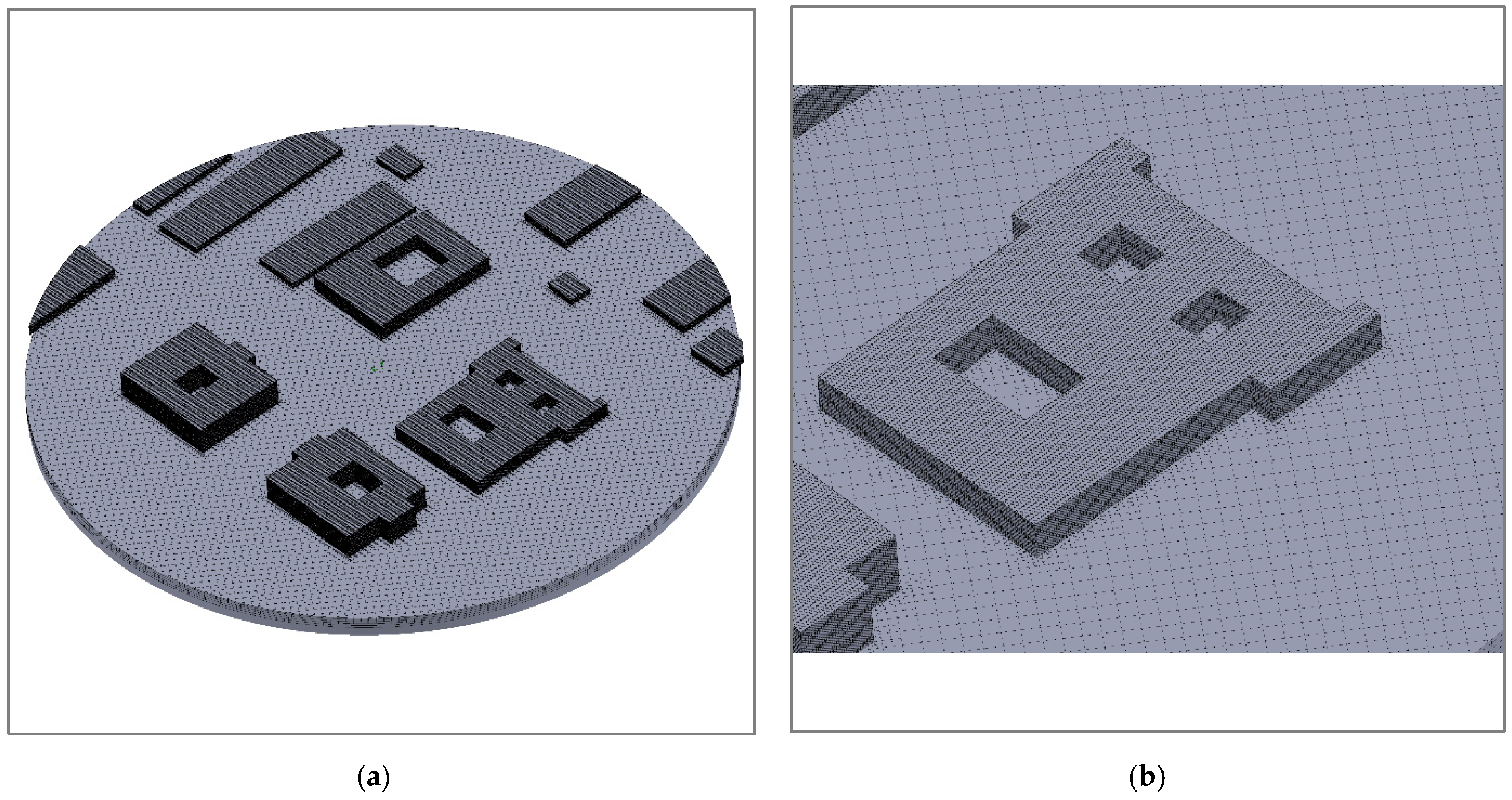

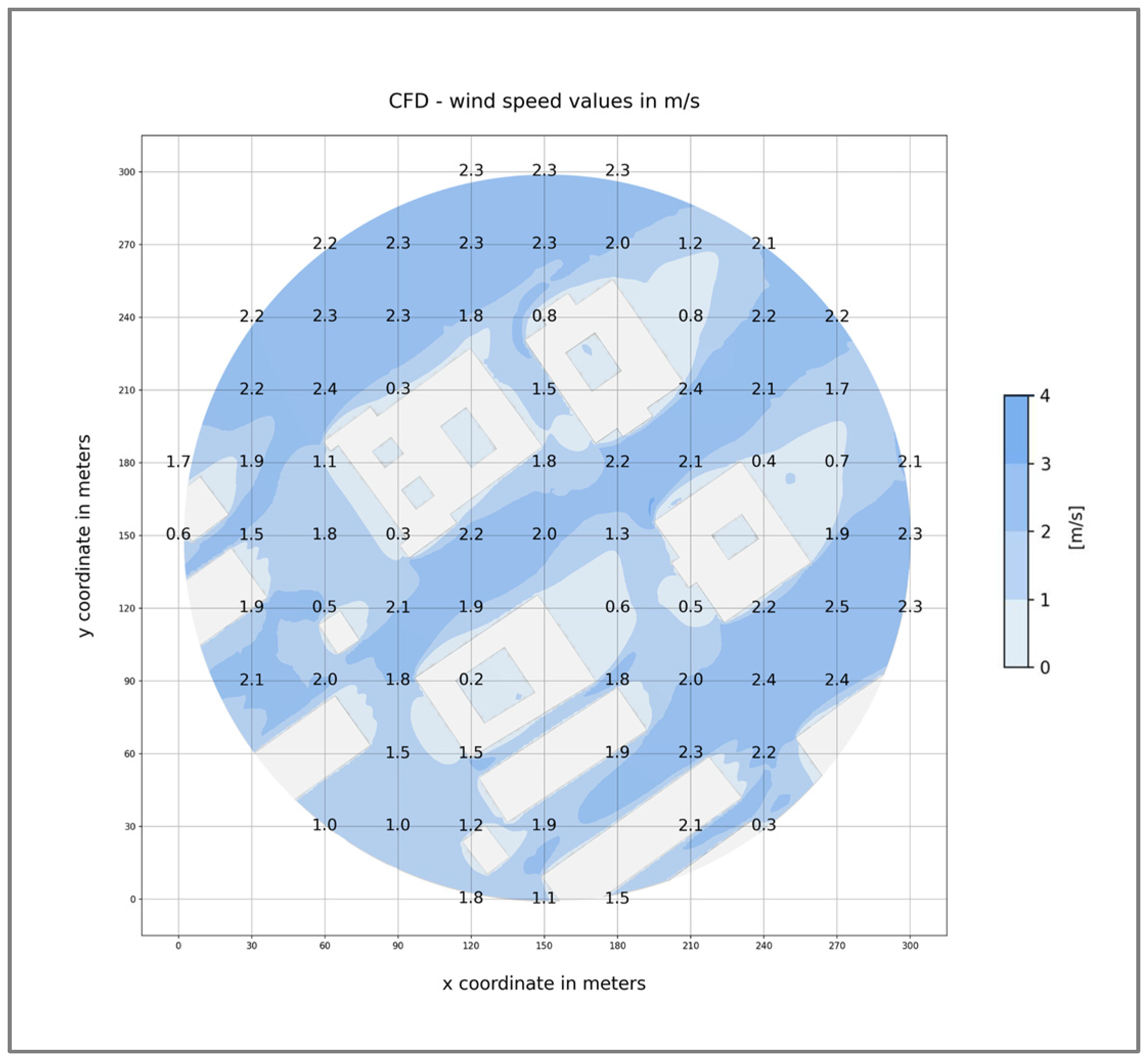
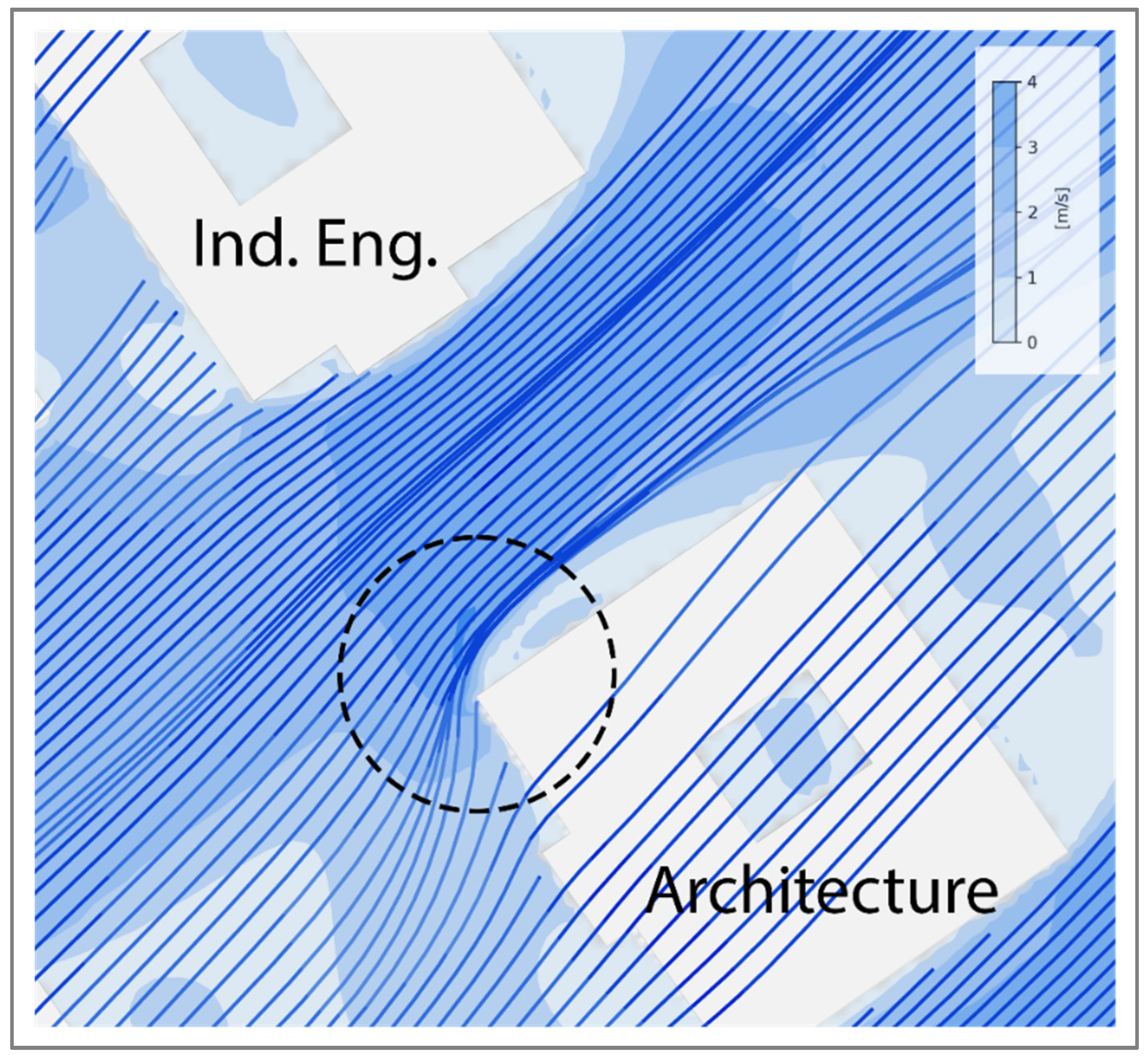

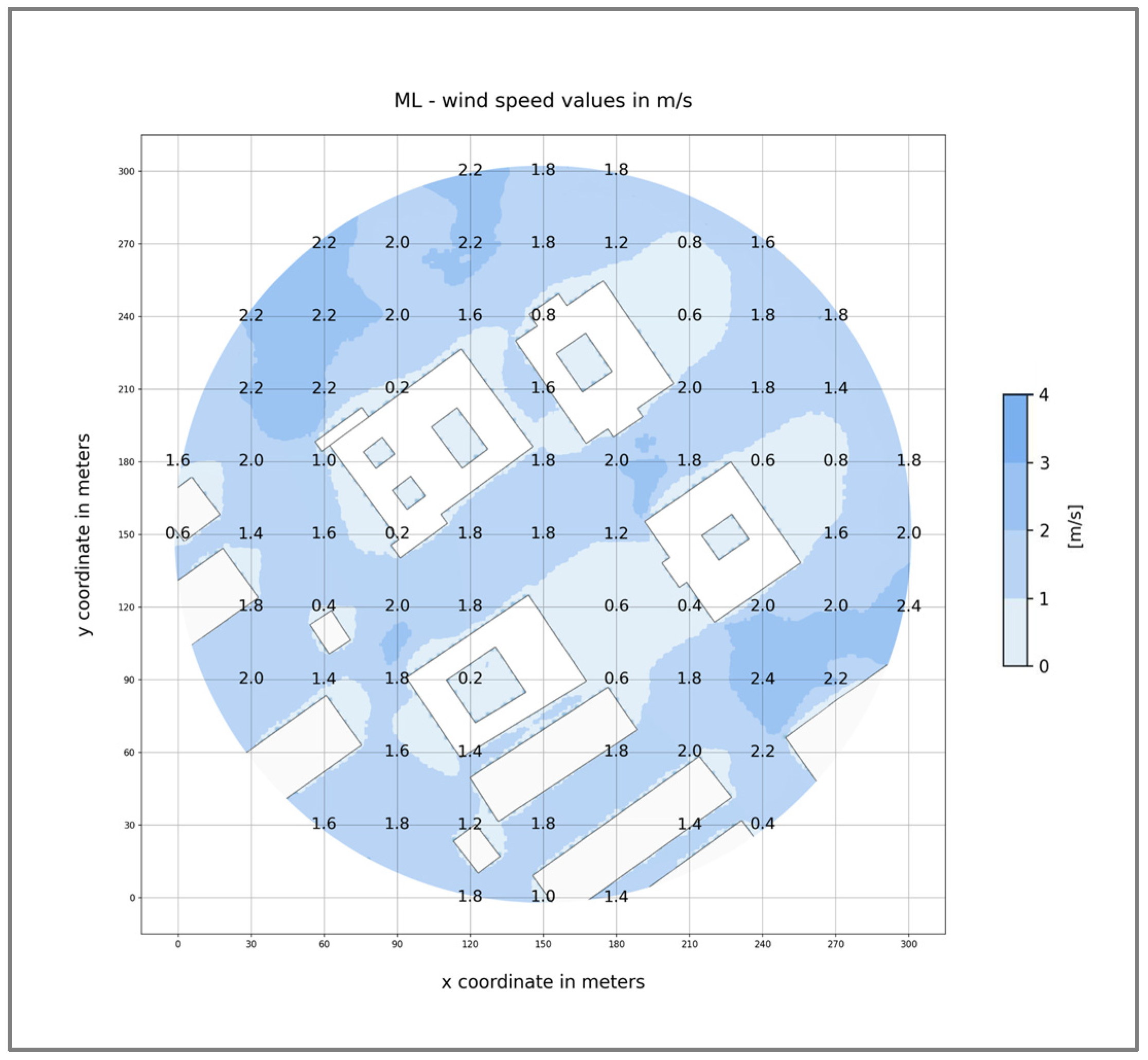

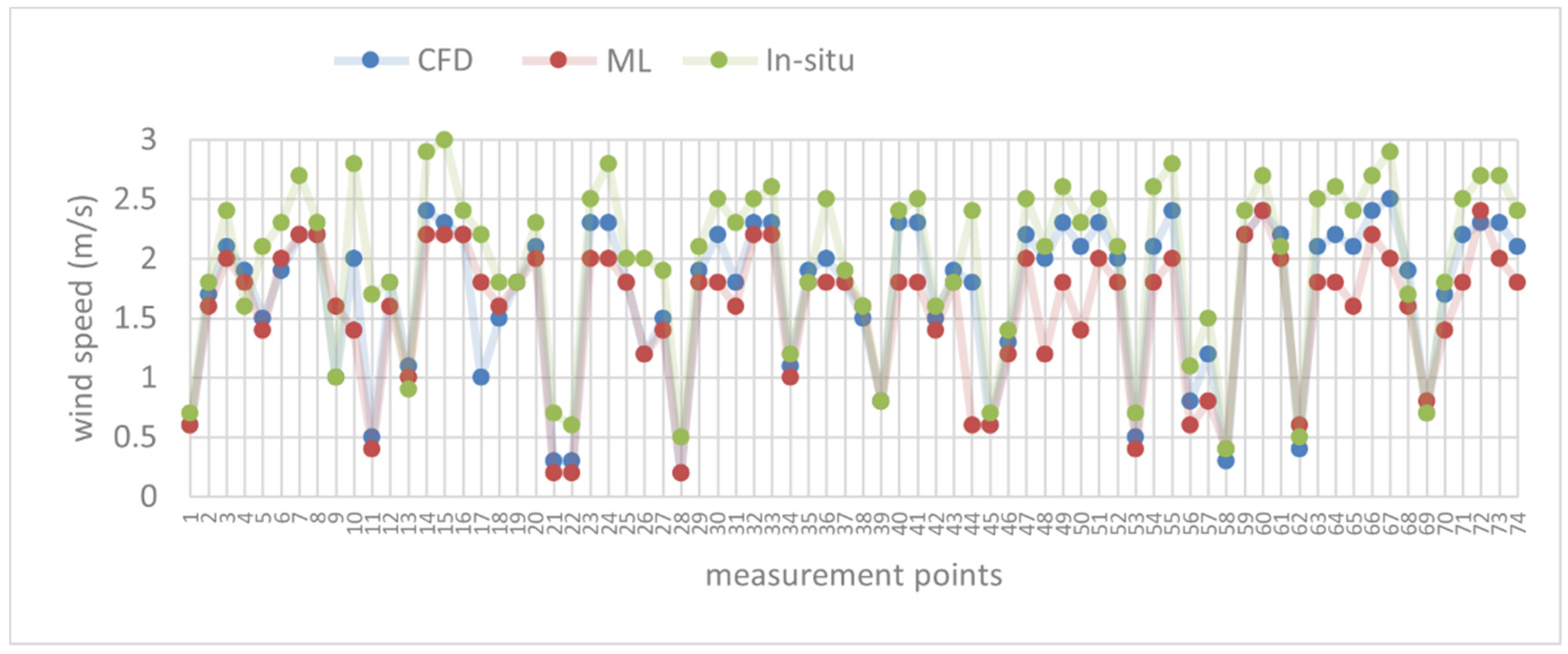

| Focus Area | Author | Aim/Focus | Methodology | Findings |
|---|---|---|---|---|
| Wind speed–wind flow | Begam and Deepa (2019) [73] | Forecasting wind speed with accuracy | NNN | The NNN model works well for predicting wind speed. |
| Blanchard and Samanta (2020) [62] | Predicting wind speed | NAR, NARX | The NARX model performed better. | |
| Low et al. (2023) [57] | Simulations of outdoor wind speeds | U-Net | The model of U-Net serves as a standard for predicting wind flow. | |
| Wang et al. (2023) [74] | Wind flow prediction for pedestrians | GAN based SFGAN | SFGAN increases the precision of predictions. | |
| BenMoshe et al. (2023) [66] | Examine how buildings and additional aspects of cities affect wind flow | Techniques such as regression using k-Nearest Neighbors (kNNs) | kNN regression is the most accurate method. | |
| Gao et al. (2024) [16] | Fast urban wind field reconstruction | DL model | The DL model works well in predicting wind flow. | |
| Wind comfort | Werner et al., 2024 [79] | Forecasts wind comfort | U-Net | While ML models are effective at making predictions, pedestrian safety must be improved. |
| Kabošová et al. (2022) [21] | To optimize exposure to sun radiation and outside wind comfort, compare CFD with InFraRed | InFraRed | When making wind-related decisions, InFraRed is effective. | |
| Kabošová et al. (2022) [80] | Used InFraRed techniques to forecast wind in design | Early in the design process, InFraRed can improve outdoor wind comfort. | ||
| Eslamirad et al. (2023) [7] | Analyzing the connection between environmental factors and wind and thermal comfort levels | ML model | ML can be a trustworthy addition to CFD modeling. | |
| Wind load-microclimate around buildings | Fu et al., 2006 [69] | Predicts wind loads on buildings | FNN | The FNN approach could be used to generalize the functional connection of wind loads that change with the incident direction of wind and spatial positions on the roof. |
| Kong et al., 2017 [75] | Predicts the surrounding microclimate of buildings | GIS, CFD, and ANN | A combined approach may be able to forecast microclimates. | |
| Duering et al. (2020) [70] | Integrates several simulation engines to optimize the spatial arrangement of urban systems. | DL | It has been shown that DL-based estimations provide advantages in the design process. | |
| Wind-induced interference | Khanduri et al., 1997 [76] | Investigate interference effects caused by wind on buildings | ANN | An ANN technique is created to evaluate the effects of wind-induced interference on structures. |
| English and Fricke, 1999 [71] | Quantify the effects of shielding in various geometric configurations | ANN | used ANN to forecast the effects of wind in urban settings. | |
| Zhang and Zhang, 2004 [64] | Assessed the impact of interference between nearby buildings | ANN, RBF neural network (RBFNN) | When it comes to modeling and forecasting intricate wind interference between tall buildings, RBFNN is effective. |
| Mesh Type | Number of Cells | Min Cell Size Near Building | Max Wind Speed @ 1.75 m (m/s) | Mean Wind Speed @ 1.75 m (m/s) | Difference from Fine Mesh (%) |
|---|---|---|---|---|---|
| Coarse | ~3 million | 1.0 m | 5.20 | 2.60 | 6.8% |
| Medium | ~6 million | 0.75 m | 5.34 | 2.68 | 2.9% |
| Fine (used) | ~10 million | 0.50 m | 5.40 | 2.76 | - |
Disclaimer/Publisher’s Note: The statements, opinions and data contained in all publications are solely those of the individual author(s) and contributor(s) and not of MDPI and/or the editor(s). MDPI and/or the editor(s) disclaim responsibility for any injury to people or property resulting from any ideas, methods, instructions or products referred to in the content. |
© 2025 by the authors. Licensee MDPI, Basel, Switzerland. This article is an open access article distributed under the terms and conditions of the Creative Commons Attribution (CC BY) license (https://creativecommons.org/licenses/by/4.0/).
Share and Cite
Karadag, I.; Gür, M. Machine Learning for Wind Speed Estimation. Buildings 2025, 15, 1541. https://doi.org/10.3390/buildings15091541
Karadag I, Gür M. Machine Learning for Wind Speed Estimation. Buildings. 2025; 15(9):1541. https://doi.org/10.3390/buildings15091541
Chicago/Turabian StyleKaradag, Ilker, and Miray Gür. 2025. "Machine Learning for Wind Speed Estimation" Buildings 15, no. 9: 1541. https://doi.org/10.3390/buildings15091541
APA StyleKaradag, I., & Gür, M. (2025). Machine Learning for Wind Speed Estimation. Buildings, 15(9), 1541. https://doi.org/10.3390/buildings15091541








